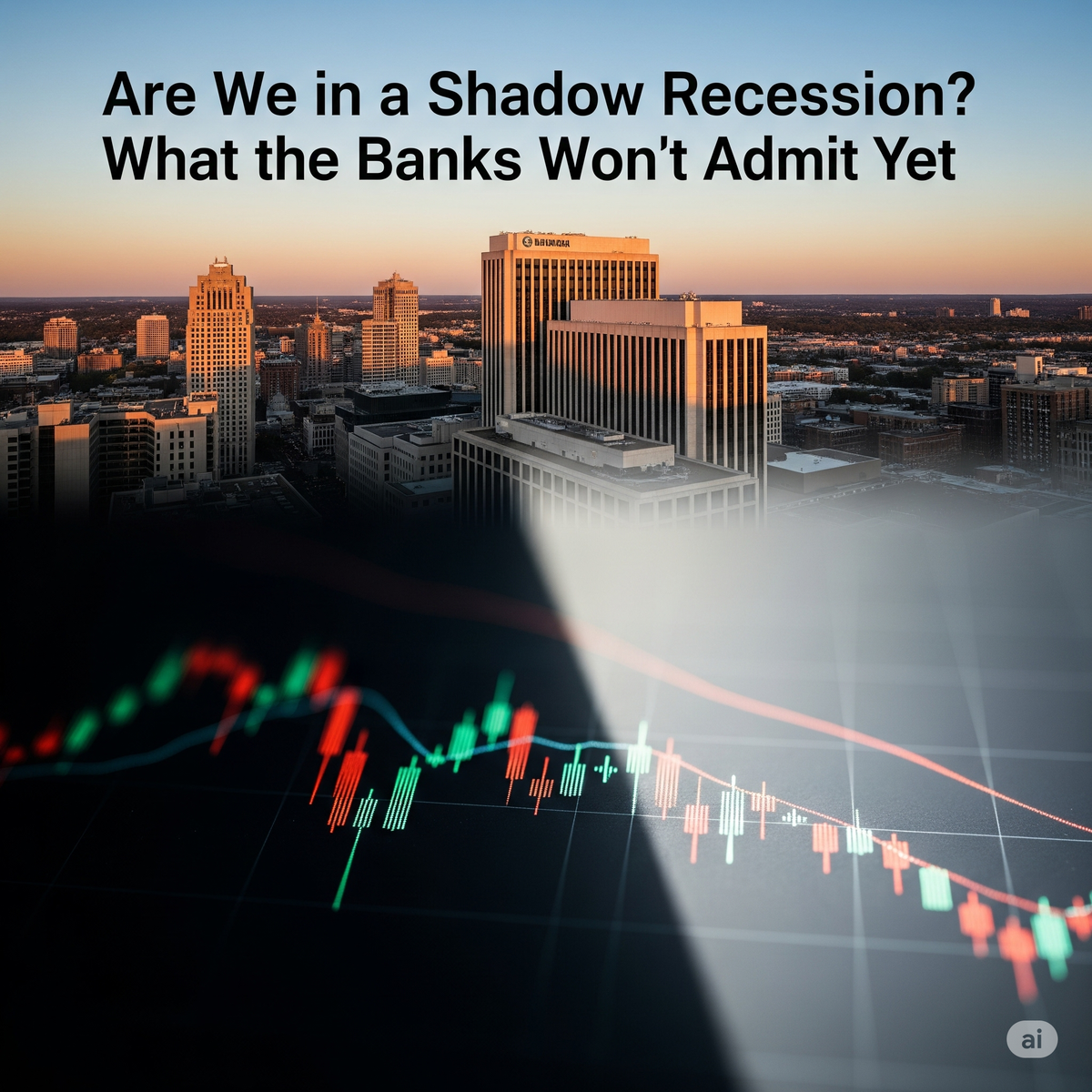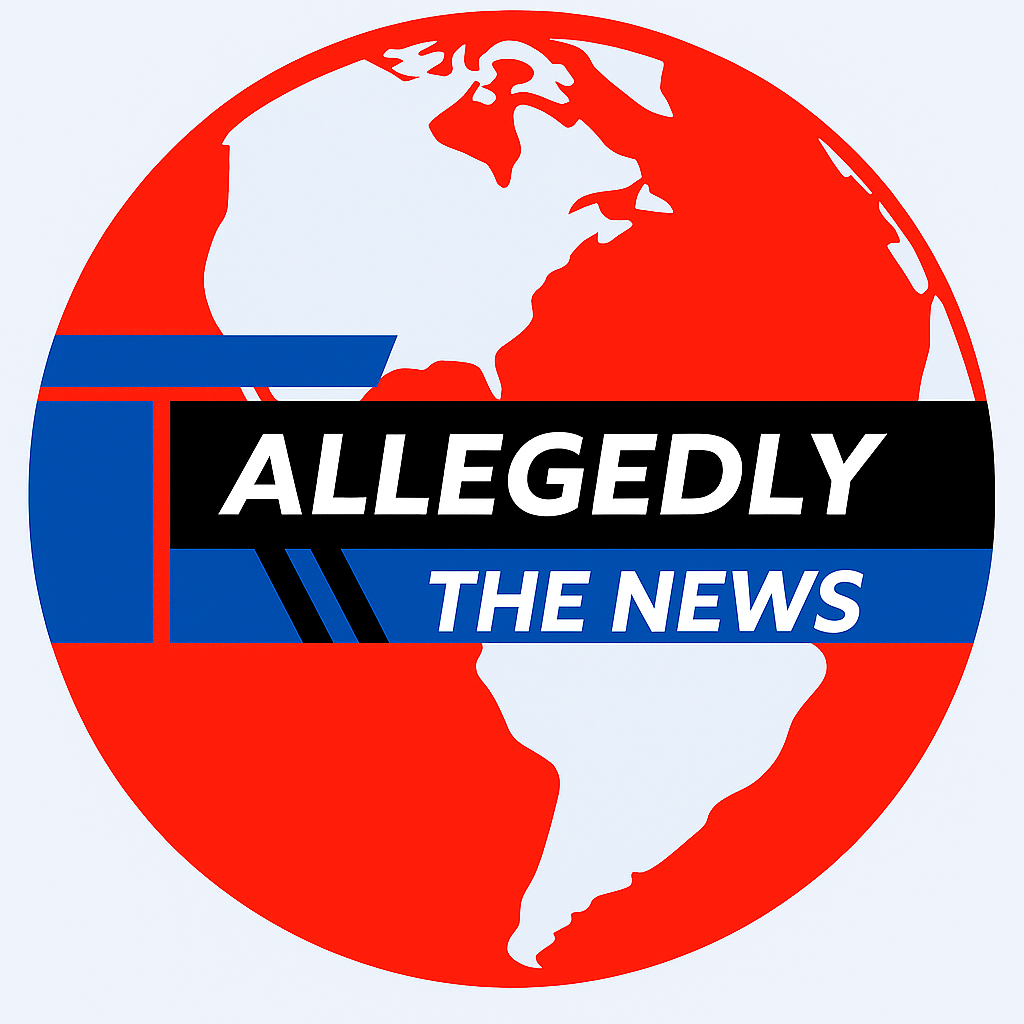Are We in a Shadow Recession? What the Banks Won’t Admit Yet
The whispers grow louder: is a "shadow recession" here, unseen by official metrics? While banks stay silent, everyday struggles hint at an economic malaise. Prepare now; the truth emerges later.

Written by Saransh kamboj – Intern, Allegedly The News
The whispers are growing louder. While official declarations remain elusive, a chilling sensation of economic slowdown is permeating households and businesses worldwide. Is the global economy teetering on the brink of a "shadow recession" a downturn the banks and financial institutions are reluctant to acknowledge, or perhaps even perceive, until it’s undeniable? As we navigate the mid-2020s, the indicators are increasingly pointing to a reality that official pronouncements may lag significantly behind.
The term "recession" traditionally conjures images of collapsing markets, mass layoffs, and outright economic contraction. The widely accepted definition, often cited as two consecutive quarters of declining Gross Domestic Product (GDP), is a backward-looking metric. By the time it's officially announced, the pain is already deeply felt. What if, however, we are experiencing a more insidious, less visible economic malaise – a "shadow recession" – where the true picture is obscured by statistical lags, selective reporting, and perhaps even a collective reluctance to admit the severity of the situation?
This blog post will delve into the nuanced signs of a potential shadow recession in 2025, exploring why the financial sector might be downplaying these realities and, most importantly, what individuals and businesses can do to prepare.

The Official Narrative vs Ground Reality: A Disconnect
Banks and central authorities often adhere strictly to conventional economic metrics. GDP, inflation rates, unemployment figures these are the pillars upon which official economic health is assessed. And while these numbers may, at times, paint a picture of resilience or moderate growth, the lived experience for many paints a different canvas.
Consider the current economic landscape in mid-2025. While some official reports might highlight pockets of growth or a seemingly stable job market, delve a little deeper, and the cracks begin to show:
- Shrinking Consumer Discretionary Spending: While essential spending on food and utilities remains relatively stable (or even increases due to inflation), discretionary purchases – dining out, new electronics, travel, luxury goods – are seeing a noticeable pullback. Consumers, squeezed by persistent inflation and stagnant real wages, are prioritizing necessities. This isn't always reflected immediately in broad GDP figures, which might be propped up by government spending or specific industry booms.
- Rising Delinquencies and Credit Stress: Recent reports, even from within the banking sector, have hinted at a slowdown in credit card growth and an increase in delinquencies, especially in consumer lending. While banks might publicly state their loan books are "stable," a creeping rise in defaults, particularly in areas like auto loans or personal loans, suggests individuals are struggling to meet their financial obligations. This credit stress can quickly cascade through the economy.
- Corporate "Optimism" vs. Layoff Announcements: Executives in boardrooms might express "cautious optimism" about future growth, yet simultaneously, news of quiet layoffs, hiring freezes, and budget cuts across various sectors continues to surface. Companies are focusing on efficiency and cost-cutting, often a precursor to broader economic tightening, even if it's not yet reflected in official unemployment spikes.
- The "K-Shaped" Reality: The post-pandemic recovery, and indeed the current economic climate, has often been described as "K-shaped." This means certain segments of the economy and population are thriving, while others are struggling. Tech giants or essential services might continue to see robust growth, masking the severe challenges faced by small businesses, certain manufacturing sectors, or low-income households. Official aggregate data can inadvertently flatten out these critical disparities.
- Supply Chain Resilience or Lack Thereof: While some supply chain issues have eased, new geopolitical tensions and protectionist trade policies (like renewed tariffs) are creating fresh disruptions. These aren't always immediate "shocks" but rather slow, persistent drags on efficiency and profitability, leading to higher input costs and ultimately, higher consumer prices or reduced corporate margins.
Why the Banks Might Be Reluctant to Admit It
The banking sector operates on confidence. A widespread public admission of an impending or ongoing recession can trigger a self-fulfilling prophecy, leading to decreased lending, reduced investment, and a further decline in consumer and business sentiment. Here are some reasons why banks might be slow to acknowledge a shadow recession:
- Avoiding Panic and Maintaining Confidence: Banks are acutely aware that their stability hinges on public trust. Announcing a downturn can lead to withdrawals, reduced borrowing, and a general tightening of credit, which exacerbates any economic slowdown. Their public statements will always err on the side of caution and optimism to maintain stability.
- Lagging Data and Official Definitions: Financial institutions largely rely on the same official data sets that governments do. Until these backward-looking metrics unequivocally signal a recession, banks are bound by the conventional definitions. They're unlikely to jump ahead of official pronouncements, even if internal models or anecdotal evidence suggest otherwise.
- Protecting Shareholder Value: Publicly traded banks have a responsibility to their shareholders. Acknowledging a recession could trigger a sell-off of their stock, impacting their market capitalization and investor confidence. This creates a strong incentive to present a positive, or at least neutral, outlook.
- Their Own Vulnerabilities: Banks themselves can be vulnerable during economic downturns. Rising loan defaults, decreased demand for new loans, and potential hits to their investment portfolios can strain their balance sheets. Admitting to a recession could expose these vulnerabilities and trigger scrutiny from regulators and investors.
- Waiting for Central Bank Cues: Banks often take their cues from central banks. Central banks, like the Reserve Bank of India (RBI) or the US Federal Reserve, are the ultimate arbiters of monetary policy and economic health. Unless a central bank signals a shift in its outlook, commercial banks are likely to maintain a consistent narrative.
The Subtle Indicators of a Shadow Recession (What to Watch For)
Beyond the official numbers, there are several "canaries in the coal mine" that can hint at a shadow recession. Keep an eye on these often-overlooked indicators:

- Inverted Yield Curve (Persistent and Deepening): Historically, an inverted yield curve (where short-term bond yields are higher than long-term yields) has been a remarkably accurate predictor of recessions. While it may not always signal an immediate recession, a prolonged and deepening inversion indicates bond investors anticipate weaker long-term growth and lower future interest rates, often due to an expected slowdown or recession.
- Rising Corporate Debt and Defaults (Private Markets): While public market data might look stable, look for increasing distress in private credit markets. Companies taking on more debt to stay afloat, or a rise in bankruptcies among small and medium-sized enterprises (SMEs) that don't make headlines, are crucial warning signs.
- Weakening Manufacturing and Industrial Production: A slowdown in manufacturing orders, factory output, and capacity utilization can be an early indicator. These sectors are often sensitive to shifts in consumer demand and business investment.
- Declining Freight and Shipping Volumes: When fewer goods are being transported globally or domestically, it's a strong signal of reduced economic activity. Shipping companies, both sea and land, often have an early pulse on demand.
- Softening Real Estate Markets (Beyond Interest Rates): While rising interest rates certainly impact housing, a significant slowdown in sales volumes, increasing days on market, or price reductions that go beyond interest rate adjustments suggest a deeper lack of consumer confidence and purchasing power. Commercial real estate, particularly office spaces, can also be a bellwether.
- Increased Job Hoarding or Reduced Labor Mobility: Instead of outright layoffs, companies might simply stop hiring, or employees might become less willing to leave stable jobs for new opportunities. This reduces churn in the labor market and can signal underlying uncertainty, even if the unemployment rate remains "low."
- Inventory Build-up: If businesses are producing goods that aren't selling, it leads to an accumulation of inventory. This eventually forces production cuts, which can then lead to layoffs. Watch for rising inventory-to-sales ratios.
- Tightening Lending Standards (Beyond Monetary Policy): Even if central banks aren't explicitly raising rates, if commercial banks become more cautious about lending to businesses and individuals, it can choke off economic activity. This tightening might not be announced but observed through stricter loan approval processes and higher credit score requirements.
Preparing for the Unspoken: A Proactive Approach
Regardless of whether an official recession is declared, preparing for a period of economic tightening is always a prudent strategy. Here's how individuals and businesses can build resilience:
For Individuals:
- Build a Robust Emergency Fund: Aim for 6-12 months of living expenses in an easily accessible, high-yield savings account. This is your primary buffer against job loss or unexpected expenses.
- Reduce High-Interest Debt: Prioritize paying down credit card debt, personal loans, and other high-interest obligations. This frees up cash flow and reduces financial vulnerability.
- Diversify Income Streams: Explore side hustles, freelance work, or develop new skills that can provide alternative income if your primary job is affected.
- Review and Cut Discretionary Spending: Audit your budget and identify areas where you can reduce non-essential expenses. Every little bit saved can strengthen your financial position.
- Maintain and Update Your Resume/Skills: Be prepared for potential job market shifts. Keep your professional network active and consider acquiring new, in-demand skills.
- Avoid Large, Non-Essential Purchases: Delay major purchases like new cars or home renovations that involve significant debt until economic clarity improves.
- Stay Informed, Not Panicked: Keep an eye on economic news from various sources, but avoid succumbing to fear. Focus on actionable steps rather than speculative worries.

For Businesses:
- Optimize Cash Flow and Liquidity: Focus on managing receivables, payables, and inventory to maintain a healthy cash position. Establish or expand lines of credit for emergencies.
- Diversify Customer Base and Revenue Streams: Reduce reliance on a single major client or product. Explore new markets or service offerings.
- Control Costs and Improve Efficiency: Conduct a thorough review of operational expenses and identify areas for efficiency gains. This includes technology adoption to streamline processes.
- Strengthen Supply Chains: Diversify suppliers and build stronger relationships to mitigate against future disruptions and cost increases.
- Retain and Upskill Key Talent: Invest in your best employees. Losing talent can be more costly in the long run than managing through a downturn. Cross-train staff to increase flexibility.
- Scenario Planning: Develop contingency plans for various economic scenarios – mild slowdown, moderate contraction, and severe recession. How would each impact your business, and what actions would you take?
- Maintain Strong Relationships with Lenders: Communicate openly with your bank. A proactive approach can lead to better terms if you need financing during a tough period.
- Focus on Value Proposition: In a challenging economy, customers become more discerning. Reiterate your unique value proposition and how you solve their problems effectively.
The Unseen Hand of Policy and Global Dynamics
The current global economic climate is further complicated by political uncertainties, ongoing geopolitical conflicts, and the specter of protectionism (e.g., renewed tariff threats). These factors can have a profound impact on trade, investment, and inflation, often creating a volatile environment where the "official" picture may not capture the full extent of underlying stresses. Central banks, while aiming for price stability and full employment, walk a tightrope, balancing inflation control with the risk of stifling growth. Their decisions on interest rates, while necessary, can ripple through the economy, sometimes exacerbating the very slowdown they seek to prevent.

Conclusion: Trusting Your Gut, Preparing for What's Next
While official institutions may continue to deliberate and define, the collective sentiment of consumers and businesses often serves as a more immediate barometer of economic health. The signs of a "shadow recession" in 2025 are becoming increasingly visible for those willing to look beyond headline figures. From shifting consumer behavior and rising credit stress to a cautious corporate landscape, the underlying currents suggest a period of sustained economic challenge.
By understanding these subtle indicators and proactively strengthening personal and business finances, we can navigate the uncertainties ahead with greater resilience. The banks may not admit it yet, but preparing for a downturn is not about panic; it's about pragmatic foresight in an evolving economic reality.
Sources
- The Indian Express – "5 Signs a Recession Could Be Around The Corner In 2025"
- https://www.youtube.com/watch?v=YOUR_YOUTUBE_LINK(Please replace with actual YouTube link if available)
- FocusEconomics – "The Top Economic Signs and Indicators of a Recession"
- World Economic Forum – "Why don't we see bad things coming? Real foresight isn't so simple"
- Trading Economics – "India Consumer Spending"
- Times of India – "'Consumers spend more on durables, FMCG in FY25'"
- TransUnion CIBIL Newsroom – "Consumption-Led Credit Product Delinquencies Continued to Steady During January to March Quarter"
For more legal exposes and truth-behind-glamour stories, subscribe to AllegedlyNewsNetwork.com




